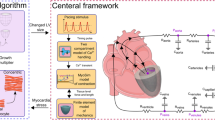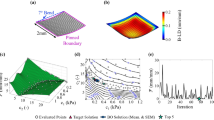Abstract
The rupture of coronary atherosclerotic plaque fibrous caps has been associated with acute myocardial infarctions. Collagen fibers, the main structural component of vascular tissue, have been observed to change orientation and align themselves with the principal stress direction. This study compared the principal stress direction in stenosed coronary arteries obtained from 3D fluid–structure interaction simulations to the orientation of collagen fibers in the fibrous cap of human specimens. The principal stress direction at the peak of the stenosis was found to be axially oriented and correlated well with the determined orientation of the collagen fibers in the fibrous cap specimens.








Similar content being viewed by others
References
Adiguzel E, Ahmad PJ, Franco C, Bendeck MP (2009) Collagens in the progression and complications of atherosclerosis. Vasc Med 14(1):73–89. doi:10.1177/1358863X08094801
Arts T, Costa KD, Covell JW, McCulloch AD (2001) Relating myocardial laminar architecture to shear strain and muscle fiber orientation. Am J Physiol Heart Circ Physiol 280(5):H2222–H2229
Bancroft JD, Stevens A (1982) Theory and practice of histological techniques, 2nd edn. Churchill-Livingston, NY
Berne RM, Levy MN (1967) Cardiovascular physiology. Mosby, St. Louis
Cilla M, Pena E, Martinez MA (2012) 3D computational parametric analysis of eccentric atheroma plaque: influence of axial and circumferential residual stresses. Biomech Model Mechanobiol 11(7):1001–1013. doi:10.1007/s10237-011-0369-0
Creane A, Maher E, Sultan S, Hynes N, Kelly D, Lally C (2011) Prediction of fibre architecture and adaptation in diseased carotid bifurcations. Biomech Model Mechanobiol 10(6):831–843. doi:10.1007/s10237-010-0277-8
Deguchi JO, Aikawa E, Libby P, Vachon JR, Inada M, Krane SM, Whittaker P, Aikawa M (2005) Matrix metalloproteinase-13/collagenase-3 deletion promotes collagen accumulation and organization in mouse atherosclerotic plaques. Circulation 112(17):2708–2715. doi:10.1161/CIRCULATIONAHA.105.562041
Di Lullo GA, Sweeney SM, Korkko J, Ala-Kokko L, San Antonio JD (2002) Mapping the ligand-binding sites and disease-associated mutations on the most abundant protein in the human, type I collagen. J Biol Chem 277(6):4223–4231. doi:10.1074/jbc.M110709200
Dolla WJ, House JA, Marso SP (2012) Stratification of risk in thin cap fibroatheromas using peak plaque stress estimates from idealized finite element models. Med Eng Phys 34(9):1330–1338. doi:10.1016/j.medengphy.2011.12.024
Driessen NJ, Boerboom RA, Huyghe JM, Bouten CV, Baaijens FP (2003) Computational analyses of mechanically induced collagen fiber remodeling in the aortic heart valve. J Biomech Eng 125(4):549–557
Driessen NJ, Wilson W, Bouten CV, Baaijens FP (2004) A computational model for collagen fibre remodelling in the arterial wall. J Theor Biol 226(1):53–64
Finet G, Ohayon J, Rioufol G (2004) Biomechanical interaction between cap thickness, lipid core composition and blood pressure in vulnerable coronary plaque: impact on stability or instability. Coron Artery Dis 15(1):13–20
Finlay HM, McCullough L, Canham PB (1995) Three-dimensional collagen organization of human brain arteries at different transmural pressures. J Vasc Res 32(5):301–312
Fujii K, Kobayashi Y, Mintz GS, Takebayashi H, Dangas G, Moussa I, Mehran R, Lansky AJ, Kreps E, Collins M, Colombo A, Stone GW, Leon MB, Moses JW (2003) Intravascular ultrasound assessment of ulcerated ruptured plaques: a comparison of culprit and nonculprit lesions of patients with acute coronary syndromes and lesions in patients without acute coronary syndromes. Circulation 108(20):2473–2478. doi:10.1161/01.CIR.0000097121.95451.39
Fung YC (1991) What are the residual stresses doing in our blood vessels? Ann Biomed Eng 19(3):237–249
Galaz R, Pagiatakis C, Gaillard E, Mongrain R (2013) A parameterized analysis of the mechanical stress for coronary plaque fibrous caps. J Biomed Sci Eng 6:36–46. doi:10.4236/jbise.2013.612A006
Gasser TC, Ogden RW, Holzapfel GA (2006) Hyperelastic modelling of arterial layers with distributed collagen fibre orientations. J R Soc Interface 3(6):15–35. doi:10.1098/rsif.2005.0073
Giattina SD, Courtney BK, Herz PR, Harman M, Shortkroff S, Stamper DL, Liu B, Fujimoto JG, Brezinski ME (2006) Assessment of coronary plaque collagen with polarization sensitive optical coherence tomography (PS-OCT). Int J Cardiol 107(3):400–409. doi:10.1016/j.ijcard.2005.11.036
Hariton I, de Botton G, Gasser TC, Holzapfel GA (2007) Stress-driven collagen fiber remodeling in arterial walls. Biomech Model Mechanobiol 6(3):163–175. doi:10.1007/s10237-006-0049-7
Hiro T, Fujii T, Yoshitake S, Kawabata T, Yasumoto K, Matsuzaki M (2000) Longitudinal visualization of spontaneous coronary plaque rupture by 3D intravascular ultrasound. Circulation 101(12):E114–E115
Holzapfel GA, Sommer G, Gasser CT, Regitnig P (2005) Determination of layer-specific mechanical properties of human coronary arteries with nonatherosclerotic intimal thickening and related constitutive modeling. Am J Physiol Heart Circ Physiol 289(5):H2048–H2058. doi:10.1152/ajpheart.00934.2004
Huang X, Yang C, Zheng J, Bach R, Muccigrosso D, Woodard PK, Tang D (2014) Higher critical plaque wall stress in patients who died of coronary artery disease compared with those who died of other causes: a 3D FSI study based on ex vivo MRI of coronary plaques. J Biomech 47(2):432–437. doi:10.1016/j.jbiomech.2013.11.007
Imoto K, Hiro T, Fujii T, Murashige A, Fukumoto Y, Hashimoto G, Okamura T, Yamada J, Mori K, Matsuzaki M (2005) Longitudinal structural determinants of atherosclerotic plaque vulnerability: a computational analysis of stress distribution using vessel models and three-dimensional intravascular ultrasound imaging. J Am Coll Cardiol 46(8):1507–1515. doi:10.1016/j.jacc.2005.06.069
Kelle S, Hays AG, Hirsch GA, Gerstenblith G, Miller JM, Steinberg AM, Schar M, Texter JH, Wellnhofer E, Weiss RG, Stuber M (2011) Coronary artery distensibility assessed by 3.0 Tesla coronary magnetic resonance imaging in subjects with and without coronary artery disease. Am J Cardiol 108(4):491–497. doi:10.1016/j.amjcard.2011.03.078
Kuhl E, Garikipati K, Arruda EM, Grosh K (2005) Remodeling of biological tissue: mechanically induced reorientation of a transversely isotropic chain network. J Mech Phys Solids 53(7):1552–1573. doi:10.1016/j.jmps.2005.03.002
Kuhl E, Holzapfel G (2007) A continuum model for remodeling in living structures. J Mater Sci 42(21):8811–8823. doi:10.1007/s10853-007-1917-y
Kunzelman KS, Cochran RP (1992) Stress/strain characteristics of porcine mitral valve tissue: parallel versus perpendicular collagen orientation. J Card Surg 7(1):71–78
Kunzelman KS, Cochran RP, Chuong C, Ring WS, Verrier ED, Eberhart RD (1993) Finite element analysis of the mitral valve. J Heart Valve Dis 2(3):326–340
Kural MH, Cai M, Tang D, Gwyther T, Zheng J, Billiar KL (2012) Planar biaxial characterization of diseased human coronary and carotid arteries for computational modeling. J Biomech 45(5):790–798. doi:10.1016/j.jbiomech.2011.11.019
Li LP, Cheung JT, Herzog W (2009) Three-dimensional fibril-reinforced finite element model of articular cartilage. Med Biol Eng Comput 47(6):607–615. doi:10.1007/s11517-009-0469-5
Li ZY, Howarth SP, Tang T, Gillard JH (2006) How critical is fibrous cap thickness to carotid plaque stability? A flow-plaque interaction model. Stroke J Cereb Circ 37(5):1195–1199. doi:10.1161/01.STR.0000217331.61083.3b
Liang X, Xenos M, Alemu Y, Rambhia SH, Lavi I, Kornowski R, Gruberg L, Fuchs S, Einav S, Bluestein D (2013) Biomechanical factors in coronary vulnerable plaque risk of rupture: intravascular ultrasound-based patient-specific fluid–structure interaction studies. Coron Artery Dis 24(2):75–87. doi:10.1097/MCA.0b013e32835bbe99
Libby P, Theroux P (2005) Pathophysiology of coronary artery disease. Circulation 111(25):3481–3488. doi:10.1161/CIRCULATIONAHA.105.537878
Little JS, Khalsa PS (2005) Material properties of the human lumbar facet joint capsule. J Biomech Eng 127(1):15–24
Loree HM, Kamm RD, Stringfellow RG, Lee RT (1992) Effects of fibrous cap thickness on peak circumferential stress in model atherosclerotic vessels. Circ Res 71(4):850–858
Mates RE, Gupta RL, Bell AC, Klocke FJ (1978) Fluid dynamics of coronary artery stenosis. Circ Res 42(1):152–162
Noorlander ML, Melis P, Jonker A, Van Noorden CJ (2002) A quantitative method to determine the orientation of collagen fibers in the dermis. J Histochem Cytochem 50(11):1469–1474
Ohayon J, Dubreuil O, Tracqui P, Le Floc’h S, Rioufol G, Chalabreysse L, Thivolet F, Pettigrew RI, Finet G (2007) Influence of residual stress/strain on the biomechanical stability of vulnerable coronary plaques: potential impact for evaluating the risk of plaque rupture. Am J Physiol Heart Circ Physiol 293(3):H1987–H1996. doi:10.1152/ajpheart.00018.2007
Rekhter MD, Zhang K, Narayanan AS, Phan S, Schork MA, Gordon D (1993) Type I collagen gene expression in human atherosclerosis. Localization to specific plaque regions. Am J Pathol 143(6):1634–1648
Sethuraman S, Amirian JH, Litovsky SH, Smalling RW, Emelianov SY (2007) Ex vivo characterization of atherosclerosis using intravascular photoacoustic imaging. Opt Express 15(25):16657–16666
Shaw JA, Kingwell BA, Walton AS, Cameron JD, Pillay P, Gatzka CD, Dart AM (2002) Determinants of coronary artery compliance in subjects with and without angiographic coronary artery disease. J Am Coll Cardiol 39(10):1637–1643
Sheehan DC, Hrapchak BB (1980) Theory and practice of histotechnology, 2nd edn. Mosby, St. Louis
Sokolis DP (2008) Passive mechanical properties and constitutive modeling of blood vessels in relation to microstructure. Med Biol Eng Comput 46(12):1187–1199. doi:10.1007/s11517-008-0362-7
Sokolis DP, Sassani S, Kritharis EP, Tsangaris S (2011) Differential histomechanical response of carotid artery in relation to species and region: mathematical description accounting for elastin and collagen anisotropy. Med Biol Eng Comput 49(8):867–879. doi:10.1007/s11517-011-0784-5
Tang D, Teng Z, Canton G, Yang C, Ferguson M, Huang X, Zheng J, Woodard PK, Yuan C (2009) Sites of rupture in human atherosclerotic carotid plaques are associated with high structural stresses: an in vivo MRI-based 3D fluid–structure interaction study. Stroke J Cereb Circ 40(10):3258–3263. doi:10.1161/STROKEAHA.109.558676
Tang D, Yang C, Zheng J, Woodard PK, Saffitz JE, Sicard GA, Pilgram TK, Yuan C (2005) Quantifying effects of plaque structure and material properties on stress distributions in human atherosclerotic plaques using 3D FSI models. J Biomech Eng 127(7):1185–1194
Tang D, Yang C, Zheng J, Woodard PK, Sicard GA, Saffitz JE, Yuan C (2004) 3D MRI-based multicomponent FSI models for atherosclerotic plaques. Ann Biomed Eng 32(7):947–960
Tremblay D, Zigras T, Cartier R, Leduc L, Butany J, Mongrain R, Leask RL (2009) A comparison of mechanical properties of materials used in aortic arch reconstruction. Ann Thorac Surg 88(5):1484–1491. doi:10.1016/j.athoracsur.2009.07.023
Valenta J, Svoboda J, Valerianova D, Vitek K (1999) Residual strain in human atherosclerotic coronary arteries and age related geometrical changes. Bio-Med Mater Eng 9(5–6):311–317
Valentin A, Humphrey JD (2009) Modeling effects of axial extension on arterial growth and remodeling. Med Biol Eng Comput 47(9):979–987. doi:10.1007/s11517-009-0513-5
Virmani RB, Burke AP, Farb A, Kolodgie FD (2002) Clinical and pathological correlates. In: Brown DL (ed) Cardiovascular plaque rupture, chap 2, vol 45. Marcel Dekker Publishers Inc, New York
Waksman RS, Serruys PW (2004) Handbook of the vulnerable plaque. Martin Dunitz, New York
WHO (2012) Cardiovascular diseases (CVDS). http://www.who.int/mediacenter/factsheets/fs317/en/index.html
Yang C, Bach RG, Zheng J, Naqa IE, Woodard PK, Teng Z, Billiar K, Tang D (2009) In vivo IVUS-based 3-D fluid–structure interaction models with cyclic bending and anisotropic vessel properties for human atherosclerotic coronary plaque mechanical analysis. IEEE Trans Bio-med Eng 56(10):2420–2428. doi:10.1109/TBME.2009.2025658
Author information
Authors and Affiliations
Corresponding author
Rights and permissions
About this article
Cite this article
Pagiatakis, C., Galaz, R., Tardif, JC. et al. A comparison between the principal stress direction and collagen fiber orientation in coronary atherosclerotic plaque fibrous caps. Med Biol Eng Comput 53, 545–555 (2015). https://doi.org/10.1007/s11517-015-1257-z
Received:
Accepted:
Published:
Issue Date:
DOI: https://doi.org/10.1007/s11517-015-1257-z




